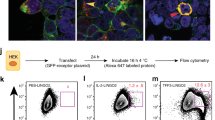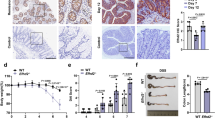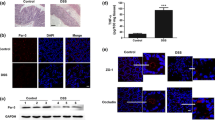Abstract
Inflammation can impair intestinal barrier, while increased epithelial permeability can lead to inflammation. In this study, we found that the expression of Tspan8, a tetraspanin expressed specifically in epithelial cells, is downregulated in mouse model of ulcerative disease (UC) but correlated with those of cell–cell junction components, such as claudins and E-cadherin, suggesting that Tspan8 supports intestinal epithelial barrier. Tspan8 removal increases intestinal epithelial permeability and upregulates IFN-γ-Stat1 signaling. We also demonstrated that Tspan8 coalesces with lipid rafts and facilitates IFNγ-R1 localization at or near lipid rafts. As IFN-γ induces its receptor undergoing clathrin- or lipid raft-dependent endocytosis and IFN-γR endocytosis plays an important role in Jak-Stat1 signaling, our analysis on IFN-γR endocytosis revealed that Tspan8 silencing impairs lipid raft-mediated but promotes clathrin-mediated endocytosis of IFN-γR1, leading to increased Stat1 signaling. These changes in IFN-γR1 endocytosis upon Tspan8 silencing correlates with fewer lipid raft component GM1 at the cell surface and more clathrin heavy chain in the cells. Our findings indicate that Tspan8 determines the IFN-γR1 endocytosis route, to restrain Stat1 signaling, stabilize intestine epithelium, and subsequently prevent intestine from inflammation. Our finding also implies that Tspan8 is needed for proper endocytosis through lipid rafts.










Similar content being viewed by others
Data availability
All data are available in the main text or the supplementary materials.
References
Odenwald MA, Turner JR (2017) The intestinal epithelial barrier: a therapeutic target? Nat Rev Gastroenterol Hepatol 14:9–21. https://doi.org/10.1038/nrgastro.2016.169
Katz KD, Hollander D, Vadheim CM et al (1989) Intestinal permeability in patients with Crohn’s disease and their healthy relatives. Gastroenterology 97:927–931. https://doi.org/10.1016/0016-5085(89)91499-6
Smalley-Freed WG, Efimov A, Burnett PE et al (2010) p120-catenin is essential for maintenance of barrier function and intestinal homeostasis in mice. J Clin Investig 120:1824–1835. https://doi.org/10.1172/JCI41414
Suzuki T (2013) Regulation of intestinal epithelial permeability by tight junctions. Cell Mol Life Sci 70:631–659. https://doi.org/10.1007/s00018-012-1070-x
Casellas F, Aguade S, Molero J (1986) Intestinal permeability in inflammatory bowel disease. Am J Gastroenterol 81:502
Schnoor M (2015) E-cadherin is important for the maintenance of intestinal epithelial homeostasis under basal and inflammatory conditions. Dig Dis Sci 60:816–818. https://doi.org/10.1007/s10620-015-3622-z
Luissint AC, Parkos CA, Nusrat A (2016) Inflammation and the intestinal barrier: leukocyte–epithelial cell interactions, cell junction remodeling, and mucosal repair. Gastroenterology 151:616–632. https://doi.org/10.1053/j.gastro.2016.07.008
Ahmad R, Sorrell MF, Batra SK, Dhawan P, Singh AB (2017) Gut permeability and mucosal inflammation: bad, good or context dependent. Mucosal Immunol 10:307–317. https://doi.org/10.1038/mi.2016.128
Meddings J (2008) What role does intestinal permeability have in IBD pathogenesis? Inflamm Bowel Dis 14(Suppl 2):S138–S139. https://doi.org/10.1002/ibd.20719
Hemler ME (2005) Tetraspanin functions and associated microdomains. Nat Rev Mol Cell Biol 6:801–811. https://doi.org/10.1038/nrm1736
Charrin S, Jouannet S, Boucheix C, Rubinstein E (2014) Tetraspanins at a glance. J Cell Sci 127:3641–3648. https://doi.org/10.1242/jcs.154906
Pan SJ, Wu YB, Cai S et al (2015) Over-expression of tetraspanin 8 in malignant glioma regulates tumor cell progression. Biochem Biophys Res Commun 458:476–482. https://doi.org/10.1016/j.bbrc.2015.01.128
El Kharbili M, Agaesse G, Barbollat-Boutrand L et al (2019) Tspan8-beta-catenin positive feedback loop promotes melanoma invasion. Oncogene 38:3781–3793. https://doi.org/10.1038/s41388-019-0691-z
Gesierich S, Paret C, Hildebrand D et al (2005) Colocalization of the tetraspanins, CO-029 and CD151, with integrins in human pancreatic adenocarcinoma: impact on cell motility. Clin Cancer Res 11:2840–2852. https://doi.org/10.1158/1078-0432.CCR-04-1935
Park CS, Kim TK, Kim HG et al (2016) Therapeutic targeting of tetraspanin8 in epithelial ovarian cancer invasion and metastasis. Oncogene 35:4540–4548. https://doi.org/10.1038/onc.2015.520
Greco C, Bralet MP, Ailane N et al (2010) E-cadherin/p120-catenin and tetraspanin Co-029 cooperate for cell motility control in human colon carcinoma. Cancer Res 70:7674–7683. https://doi.org/10.1158/0008-5472.CAN-09-4482
Wei L, Li Y, Suo Z (2015) TSPAN8 promotes gastric cancer growth and metastasis via ERK MAPK pathway. Int J Clin Exp Med 8:8599–8607
Zhu R, Gires O, Zhu L et al (2019) TSPAN8 promotes cancer cell stemness via activation of sonic Hedgehog signaling. Nat Commun 10:2863. https://doi.org/10.1038/s41467-019-10739-3
Wang H, Rana S, Giese N, Buchler MW, Zoller M (2013) Tspan8, CD44v6 and alpha6beta4 are biomarkers of migrating pancreatic cancer-initiating cells. Int J Cancer 133:416–426. https://doi.org/10.1002/ijc.28044
Ailane N, Greco C, Zhu Y et al (2014) Effect of an anti-human Co-029/tspan8 mouse monoclonal antibody on tumor growth in a nude mouse model. Front Physiol 5:364. https://doi.org/10.3389/fphys.2014.00364
Heo K, Lee S (2020) TSPAN8 as a novel emerging therapeutic target in cancer for monoclonal antibody therapy. Biomolecules. https://doi.org/10.3390/biom10030388
Schafer D, Tomiuk S, Kuster LN et al (2021) Identification of CD318, TSPAN8 and CD66c as target candidates for CAR T cell based immunotherapy of pancreatic adenocarcinoma. Nat Commun 12:1453. https://doi.org/10.1038/s41467-021-21774-4
Guo Q, Xia B, Zhang F et al (2012) Tetraspanin CO-029 inhibits colorectal cancer cell movement by deregulating cell–matrix and cell–cell adhesions. PLoS One 7:e38464. https://doi.org/10.1371/journal.pone.0038464
Sirven A, Ravet E, Charneau P et al (2001) Enhanced transgene expression in cord blood CD34(+)-derived hematopoietic cells, including developing T cells and NOD/SCID mouse repopulating cells, following transduction with modified trip lentiviral vectors. Mol Ther 3:438–448. https://doi.org/10.1006/mthe.2001.0282
Franken NA, Rodermond HM, Stap J, Haveman J, van Bree C (2006) Clonogenic assay of cells in vitro. Nat Protoc 1:2315–2319. https://doi.org/10.1038/nprot.2006.339
Zweibaum A, Pinto M, Chevalier G et al (1985) Enterocytic differentiation of a subpopulation of the human colon tumor cell line HT-29 selected for growth in sugar-free medium and its inhibition by glucose. J Cell Physiol 122:21–29. https://doi.org/10.1002/jcp.1041220105
Le Bivic A, Hirn M, Reggio H (1988) HT-29 cells are an in vitro model for the generation of cell polarity in epithelia during embryonic differentiation. Proc Natl Acad Sci USA 85:136–140. https://doi.org/10.1073/pnas.85.1.136
Matter K, Balda MS (2003) Functional analysis of tight junctions. Methods 30:228–234. https://doi.org/10.1016/s1046-2023(03)00029-x
Bai B, Tan H, Pagala VR et al (2017) Deep profiling of proteome and phosphoproteome by isobaric labeling, extensive liquid chromatography, and mass spectrometry. Methods Enzymol 585:377–395. https://doi.org/10.1016/bs.mie.2016.10.007
Wang Z, Yu K, Tan H et al (2020) 27-Plex tandem mass tag mass spectrometry for profiling brain proteome in Alzheimer’s disease. Anal Chem 92:7162–7170. https://doi.org/10.1021/acs.analchem.0c00655
Wang H, Yang Y, Li Y et al (2015) Systematic optimization of long gradient chromatography mass spectrometry for deep analysis of brain proteome. J Proteome Res 14:829–838. https://doi.org/10.1021/pr500882h
Bai B, Wang X, Li Y et al (2020) Deep multilayer brain proteomics identifies molecular networks in Alzheimer’s disease progression. Neuron 106:700. https://doi.org/10.1016/j.neuron.2020.04.031
Wang X, Li Y, Wu Z, Wang H, Tan H, Peng J (2014) JUMP: a tag-based database search tool for peptide identification with high sensitivity and accuracy. Mol Cell Proteom 13:3663–3673. https://doi.org/10.1074/mcp.O114.039586
Peng J, Elias JE, Thoreen CC, Licklider LJ, Gygi SP (2003) Evaluation of multidimensional chromatography coupled with tandem mass spectrometry (LC/LC–MS/MS) for large-scale protein analysis: the yeast proteome. J Proteome Res 2:43–50. https://doi.org/10.1021/pr025556v
Niu M, Cho JH, Kodali K et al (2017) Extensive peptide fractionation and y1 ion-based interference detection method for enabling accurate quantification by isobaric labeling and mass spectrometry. Anal Chem 89:2956–2963. https://doi.org/10.1021/acs.analchem.6b04415
Vanderwall D, Suresh P, Fu Y et al (2021) JUMPn: a streamlined application for protein co-expression clustering and network analysis in proteomics. J Vis Exp. https://doi.org/10.3791/62796
Uhlen M, Fagerberg L, Hallstrom BM et al (2015) Proteomics. Tissue-based map of the human proteome. Science 347:1260419. https://doi.org/10.1126/science.1260419
Miller HE, Bishop AJR (2021) Correlation AnalyzeR: functional predictions from gene co-expression correlations. BMC Bioinform 22:206. https://doi.org/10.1186/s12859-021-04130-7
Asao H, Okuyama C, Kumaki S et al (2001) Cutting edge: the common gamma-chain is an indispensable subunit of the IL-21 receptor complex. J Immunol 167:1–5. https://doi.org/10.4049/jimmunol.167.1.1
Subramaniam PS, Torres BA, Johnson HM (2001) So many ligands, so few transcription factors: a new paradigm for signaling through the STAT transcription factors. Cytokine 15:175–187. https://doi.org/10.1006/cyto.2001.0905
Sheikh F, Baurin VV, Lewis-Antes A et al (2004) Cutting edge: IL-26 signals through a novel receptor complex composed of IL-20 receptor 1 and IL-10 receptor 2. J Immunol 172:2006–2010. https://doi.org/10.4049/jimmunol.172.4.2006
Yoshimoto T, Okada K, Morishima N et al (2004) Induction of IgG2a class switching in B cells by IL-27. J Immunol 173:2479–2485. https://doi.org/10.4049/jimmunol.173.4.2479
de Weerd NA, Nguyen T (2012) The interferons and their receptors—distribution and regulation. Immunol Cell Biol 90:483–491. https://doi.org/10.1038/icb.2012.9
Forbes LR, Milner J, Haddad E (2016) Signal transducer and activator of transcription 3: a year in review. Curr Opin Hematol 23:23–27. https://doi.org/10.1097/MOH.0000000000000206
Marchetti M, Monier MN, Fradagrada A et al (2006) Stat-mediated signaling induced by type I and type II interferons (IFNs) is differentially controlled through lipid microdomain association and clathrin-dependent endocytosis of IFN receptors. Mol Biol Cell 17:2896–2909. https://doi.org/10.1091/mbc.e06-01-0076
Chmiest D, Sharma N, Zanin N et al (2016) Spatiotemporal control of interferon-induced JAK/STAT signalling and gene transcription by the retromer complex. Nat Commun 7:13476. https://doi.org/10.1038/ncomms13476
Subramaniam PS, Johnson HM (2002) Lipid microdomains are required sites for the selective endocytosis and nuclear translocation of IFN-gamma, its receptor chain IFN-gamma receptor-1, and the phosphorylation and nuclear translocation of STAT1alpha. J Immunol 169:1959–1969. https://doi.org/10.4049/jimmunol.169.4.1959
Sadir R, Lambert A, Lortat-Jacob H, Morel G (2001) Caveolae and clathrin-coated vesicles: two possible internalization pathways for IFN-gamma and IFN-gamma receptor. Cytokine 14:19–26. https://doi.org/10.1006/cyto.2000.0854
Hill MM, Bastiani M, Luetterforst R et al (2008) PTRF-Cavin, a conserved cytoplasmic protein required for caveola formation and function. Cell 132:113–124. https://doi.org/10.1016/j.cell.2007.11.042
McElrath C, Espinosa V, Lin JD et al (2021) Critical role of interferons in gastrointestinal injury repair. Nat Commun 12:2624. https://doi.org/10.1038/s41467-021-22928-0
Langer V, Vivi E, Regensburger D et al (2019) IFN-gamma drives inflammatory bowel disease pathogenesis through VE-cadherin-directed vascular barrier disruption. J Clin Investig 129:4691–4707. https://doi.org/10.1172/JCI124884
Ghosh S, Chaudhary R, Carpani M, Playford R (2006) Interfering with interferons in inflammatory bowel disease. Gut 55:1071–1073. https://doi.org/10.1136/gut.2005.090134
Huang C, Hays FA, Tomasek JJ, Benyajati S, Zhang XA (2020) Tetraspanin CD82 interaction with cholesterol promotes extracellular vesicle-mediated release of ezrin to inhibit tumour cell movement. J Extracell Vesicles 9:1692417. https://doi.org/10.1080/20013078.2019.1692417
Zimmerman B, Kelly B, McMillan BJ et al (2016) Crystal structure of a full-length human tetraspanin reveals a cholesterol-binding pocket. Cell 167:1041-1051 e1011. https://doi.org/10.1016/j.cell.2016.09.056
Cherukuri A, Shoham T, Sohn HW et al (2004) The tetraspanin CD81 is necessary for partitioning of coligated CD19/CD21-B cell antigen receptor complexes into signaling-active lipid rafts. J Immunol 172:370–380. https://doi.org/10.4049/jimmunol.172.1.370
Wei Q, Zhang F, Richardson MM et al (2014) CD82 restrains pathological angiogenesis by altering lipid raft clustering and CD44 trafficking in endothelial cells. Circulation 130:1493–1504. https://doi.org/10.1161/CIRCULATIONAHA.114.011096
Zilber MT, Setterblad N, Vasselon T et al (2005) MHC class II/CD38/CD9: a lipid-raft-dependent signaling complex in human monocytes. Blood 106:3074–3081. https://doi.org/10.1182/blood-2004-10-4094
Contreras FX, Ernst AM, Haberkant P et al (2012) Molecular recognition of a single sphingolipid species by a protein’s transmembrane domain. Nature 481:525–529. https://doi.org/10.1038/nature10742
Blouin CM, Hamon Y, Gonnord P et al (2016) Glycosylation-dependent IFN-gammaR partitioning in lipid and actin nanodomains is critical for JAK activation. Cell 166:920–934. https://doi.org/10.1016/j.cell.2016.07.003
Sen S, Roy K, Mukherjee S, Mukhopadhyay R, Roy S (2011) Restoration of IFNgammaR subunit assembly, IFNgamma signaling and parasite clearance in Leishmania donovani infected macrophages: role of membrane cholesterol. PLoS Pathog 7:e1002229. https://doi.org/10.1371/journal.ppat.1002229
Blouin CM, Lamaze C (2013) Interferon gamma receptor: the beginning of the journey. Front Immunol 4:267. https://doi.org/10.3389/fimmu.2013.00267
Acknowledgements
We thank Dr. Claude Boucheix for special reagents and Ms. Kathy Kyler for English editing. We acknowledge the functional genomics core of Stephenson Cancer Center at the University of Oklahoma Health Sciences Center for technical support. The Nikon N-SIM-E/STORM super-resolution microscope is supported by a Large Equipment Grant from the Oklahoma Center for Adult Stem Cell Research (OCASCR) and the OUHSC Department of Cell Biology.
Funding
This work was supported by National Institutes of Health grants HL137819, GM135547, and AG068581, OCAST grant HR20-055, and research grants from OCASCR, a program of TSET, to XAZ. XAZ is an Oklahoma TSET Cancer Research Scholar.
Author information
Authors and Affiliations
Contributions
JM designed and performed most experiments, analyzed the data, and wrote the manuscript. SY, YC, DV, SLi, JDW. SLiu, and CJ contributed bio-informatics and statistics analyses. SY, YC SLi, JW, YD, JC, and ZW performed experiments. BL, AC, ZU and TK provided technical setup and expertise. CG made Tspan8 monoclonal antibodies. JP supervised the proteomic study. XAZ conceived the study, designed experimental approaches, supervised the study, and wrote the manuscript.
Corresponding author
Ethics declarations
Conflict of interest
The authors declare no competing interests.
Additional information
Publisher's Note
Springer Nature remains neutral with regard to jurisdictional claims in published maps and institutional affiliations.
Supplementary Information
Below is the link to the electronic supplementary material.
Rights and permissions
Springer Nature or its licensor (e.g. a society or other partner) holds exclusive rights to this article under a publishing agreement with the author(s) or other rightsholder(s); author self-archiving of the accepted manuscript version of this article is solely governed by the terms of such publishing agreement and applicable law.
About this article
Cite this article
Min, J., Yang, S., Cai, Y. et al. Tetraspanin Tspan8 restrains interferon signaling to stabilize intestinal epithelium by directing endocytosis of interferon receptor. Cell. Mol. Life Sci. 80, 154 (2023). https://doi.org/10.1007/s00018-023-04803-x
Received:
Revised:
Accepted:
Published:
DOI: https://doi.org/10.1007/s00018-023-04803-x




